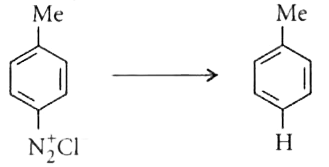The synthesis of alkyl fluorides is best accomplished by:
Free radical fluorination
Sandmeyer's reaction
Finkelstein reaction
Swarts reaction
To determine the best method for synthesizing alkyl fluorides, we can analyze the options provided and their respective mechanisms. Here is a step-by-step solution:
Step 1: Understand the Definition of Alkyl Fluorides
Alkyl fluorides are organic compounds where a fluorine atom replaces a hydrogen atom in an alkyl group. They can be represented as R-F, where R is an alkyl group.
Hint: Alkyl fluorides are simply alkyl groups bonded to fluorine.
Step 2: Review the Options Given
The options provided for the synthesis of alkyl fluorides are:
1. Free radical fluorination
2. Sandmeyer reaction
3. Finkelstein reaction
4. Swartz reaction
Hint: Look at each reaction type and determine if it can effectively introduce a fluorine atom into an alkyl group.
Step 3: Analyze Free Radical Fluorination
Free radical fluorination involves the reaction of an alkane with fluorine gas (F2) under radical conditions. However, fluorine is highly reactive and can lead to multiple substitutions or even explosive reactions, making it unsuitable for selective synthesis of alkyl fluorides.
Hint: Consider the reactivity of fluorine and the potential for side reactions.
Step 4: Analyze the Sandmeyer Reaction
The Sandmeyer reaction is used to convert aryl amines into aryl halides using copper salts. It does not apply to alkyl halides or alkyl fluorides, as it specifically deals with aromatic compounds.
Hint: Remember that the Sandmeyer reaction is not applicable to alkyl groups.
Step 5: Analyze the Finkelstein Reaction
The Finkelstein reaction involves the exchange of halogens, typically using sodium iodide (NaI) to replace a halogen (like Cl or Br) with iodine. However, sodium fluoride (NaF) is a poor leaving group, making this reaction inefficient for synthesizing alkyl fluorides.
Hint: Consider the leaving group ability of NaF in the Finkelstein reaction.
Step 6: Analyze the Swartz Reaction
The Swartz reaction is a method specifically designed for the synthesis of alkyl fluorides. It involves the reaction of an alkyl halide (R-X) with silver fluoride (AgF). This reaction is effective because AgF provides a good source of fluoride, allowing for the substitution of the halogen with fluorine.
Hint: Look for a reaction that specifically produces alkyl fluorides from alkyl halides.
Step 7: Conclusion
After analyzing all the options, the best method for synthesizing alkyl fluorides is the Swartz reaction.
Final Answer: The synthesis of alkyl fluorides is best accomplished by the Swartz reaction (Option 4).
Alkyl fluorides are organic compounds where a fluorine atom replaces a hydrogen atom in an alkyl group. They can be represented as R-F, where R is an alkyl group.
The options provided for the synthesis of alkyl fluorides are:
1. Free radical fluorination
2. Sandmeyer reaction
3. Finkelstein reaction
4. Swartz reaction
Free radical fluorination involves the reaction of an alkane with fluorine gas (F2) under radical conditions. However, fluorine is highly reactive and can lead to multiple substitutions or even explosive reactions, making it unsuitable for selective synthesis of alkyl fluorides.
The Sandmeyer reaction is used to convert aryl amines into aryl halides using copper salts. It does not apply to alkyl halides or alkyl fluorides, as it specifically deals with aromatic compounds.
The Finkelstein reaction involves the exchange of halogens, typically using sodium iodide (NaI) to replace a halogen (like Cl or Br) with iodine. However, sodium fluoride (NaF) is a poor leaving group, making this reaction inefficient for synthesizing alkyl fluorides.
The Swartz reaction is a method specifically designed for the synthesis of alkyl fluorides. It involves the reaction of an alkyl halide (R-X) with silver fluoride (AgF). This reaction is effective because AgF provides a good source of fluoride, allowing for the substitution of the halogen with fluorine.
After analyzing all the options, the best method for synthesizing alkyl fluorides is the Swartz reaction.
Topper's Solved these Questions
- SAMPLE PAPER 11 (SELF-ASSESSMENT)BOOK - EDUCART PUBLICATIONCHAPTER - SAMPLE PAPER 11 (SELF-ASSESSMENT)EXERCISE - SECTION - B
21 Videos
- SAMPLE PAPER 11 (SELF-ASSESSMENT)BOOK - EDUCART PUBLICATIONCHAPTER - SAMPLE PAPER 11 (SELF-ASSESSMENT)EXERCISE - SECTION - C
4 Videos
- SAMPLE PAPER 10BOOK - EDUCART PUBLICATIONCHAPTER - SAMPLE PAPER 10EXERCISE - SECTION - C
5 Videos
- SAMPLE PAPER 3BOOK - EDUCART PUBLICATIONCHAPTER - SAMPLE PAPER 3EXERCISE - SECTION- C
6 Videos
Similar Questions
Knowledge Check
The synthesis of alkyl fluoride is best accomplished by:
AFinkelstein reactionBSwart's reactionCFree radical mechanismDSandmeyer's reaction.The synthesis of alkyl fluoride is best accomplished by:
AFinkelestein reactionBSwarts reactionCFree radical fluorinationDSandmeyer's reactionThe conversion of acetophenone to acetanilide is best accomplished by using :
ABeckmann rearrangementBCurtius rearrangementCLossen rearrangementDHofmann rearrangement
The reagent with which the following reactions is best accomplished is

View SolutionThe process of digestion is accomplished by :−
View SolutionProcess of digestion is accomplished by -
View SolutionSomatic hybridization is accomplished by
View SolutionIn Williamson's synthesis , tert-alkyl halides CANNOT be used because ___________.
View Solution
